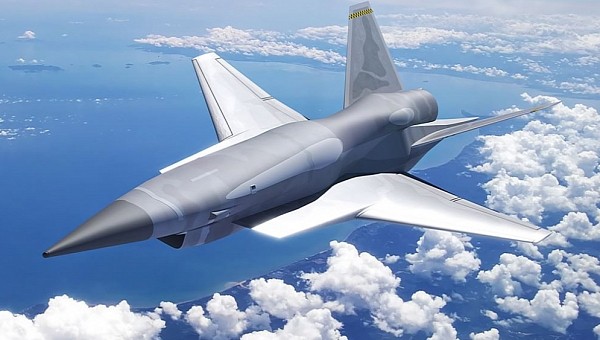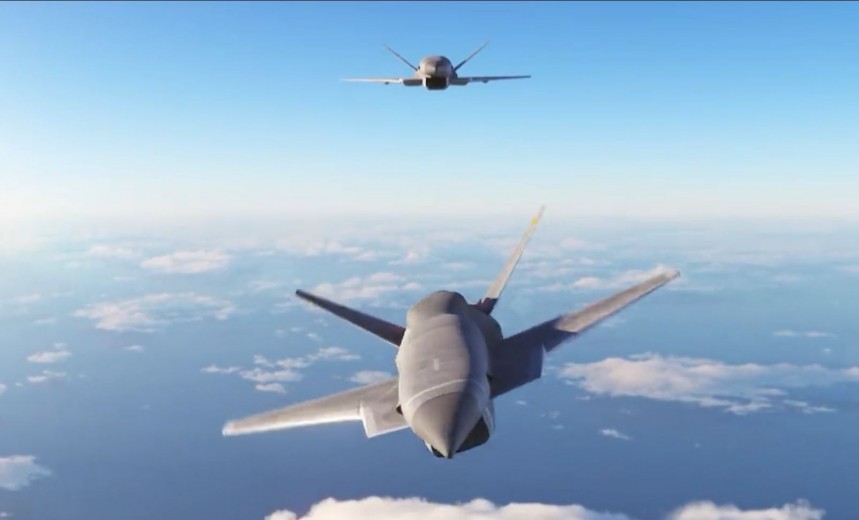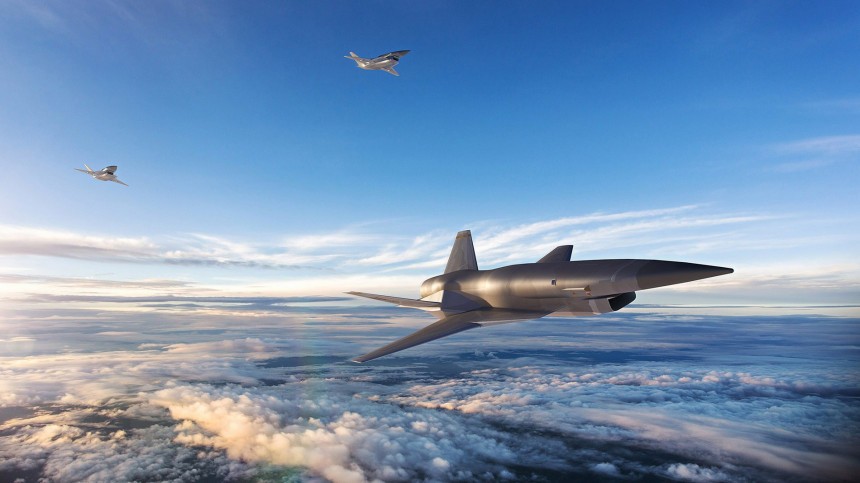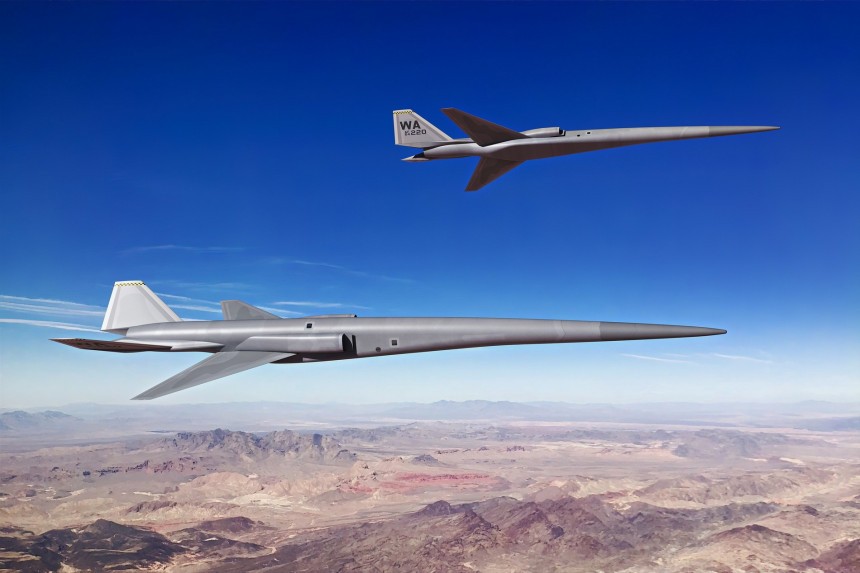Fifth-generation fighter jets aren't the sole domain of the U.S. anymore. Russia and China currently field jet fighters that, at least on paper, match the capabilities of the F-22 Raptor and the F-35 Lightning II. This presents an interesting set of problems on the part of NATO.
F-22 pilots can spend all day, and then some, doing mock dogfights with other Raptor pilots. Or, they could busy themselves with mock aggressor squadrons comprised of inferior gen-IV fighters or sub-sonic UAVs that are little more than target practice. For decades, U.S. Air Force Agressor Squadrons have employed domestic fighters like F-5 Freedom Fighters and F-16 Fighting Falcons to create the illusion of enemy Air Forces for training purposes.
But if any of the propaganda around the Russian Su-57, in particular, is to be believed, its capabilities exceed even that of the F-16. With that in mind, what NATO, and therefore the U.S., crave desperately is a tool that can mimic adversarial gen-V fighters' speed and combat capability. You know, without having to go behind enemy lines in a helicopter to crane a prized enemy stealth fighter home a-la Operation Mount Hope III.
With this in mind, say hello to the Exosonic Revenant. A supersonic-capable UAV drone built to mimic the best hostile fighter jets the U.S. is liable to come across. Though it may look like a flaming pencil or a scaled-down F-16 with the cockpit removed. But don't be fooled. This novel, un-crewed jet's on-paper capabilities are far greater than you might think. Let's take a look at some of the details.
But first, who even is Exosonic, and why do they think they're capable of mimicking adversarial modern fighter jets for NATO pilots to test their grit against? Well, like other recent aerospace startups like Boom Technologies, Exosonic has its sights firmly set on supersonic commercial aviation.
If nothing else, the Revenant UAV serves as a technological demonstrator for hardware slated to be implemented in a full-sized airliner. Exosonic seems confident this can be achieved sometime before this decade is out, even with an advertised employee count numbering just 14. With this in mind, it should be no shock Exosonic's most notable initiative is as a design partner to study how to make Air Force One supersonic.
But building the spiritual successor to Concorde for the U.S. President to jet around might be more of a pie-in-the-sky ambition. That's despite the admittedly brilliant-looking promotional material. But as far as the Revenant supersonic UAV is concerned, that might soon start paying dividends very soon.
With support from the American Department of Defense, there's reason to suspect Revenant is well on its way. Exosonic's webpage is the best place to find admittedly scarce information on this DOD-funded, partially-classified military project. But to the company's credit, computer-generated graphics of the Revenant in action at least make it easy to deduce a few things about this UAV's makeup.
Though the Revenant platform is meant to duplicate a flagship twin-engine gen-V jet, the plane itself is a slender, single-engine design. One can only assume this configuration was chosen in the name of saving weight as opposed to physically looking like the jets they're trying to mimic.
But thanks to Revenant's highly modular platform, or "open system architecture," as Exosonic calls it, there are plenty of other ways to mimic contemporary military jets. Everything from active electronically scanned array (AESA) radar, Infrared Search and Track (IRST) capability, and high bitrate data-link similar to what's found on an F22 Raptor make for a package that's no doubt pleasing to NATO air power.
Powered by a single afterburning turbojet engine of unspecified origins, the Revenant platform almost impersonates a cruise missile in its design principals principal. One could even assume Revenant is an upgrade package for the AGM-129 cruise missiles that B-52s used to carry without prior knowledge.
Whatever the specifics, a top speed of 1.2 times the speed of sound (920 mph, 1,481.76 kph) should be fast enough to simulate the speeds of most frontline fighters built in the last 40 years. The benefits of this in a hypothetical adversarial training squadron that Raptor and Lightning pilots can cut their teeth against should speak for themselves.
Keep in mind the Russians and Chinese also wield powerful UAVs, which they intend to use in conflict against NATO. Just Google photos of the Sukhoi S-70 Okhotnik-B or the Hongdu GJ-11 if you don't believe us. From this perspective, Exosonic's Revenant, at least on paper, exceeds the speeds that even these the newest operational Russian and Chinese UAVs can manage.
No word yet on when we'll see the first working examples. But with U.S. Agressor Squadrons already strapped for new airframes, expect a supersonic UAV to be a top priority for NATO for the duration of the 2020s.
But if any of the propaganda around the Russian Su-57, in particular, is to be believed, its capabilities exceed even that of the F-16. With that in mind, what NATO, and therefore the U.S., crave desperately is a tool that can mimic adversarial gen-V fighters' speed and combat capability. You know, without having to go behind enemy lines in a helicopter to crane a prized enemy stealth fighter home a-la Operation Mount Hope III.
With this in mind, say hello to the Exosonic Revenant. A supersonic-capable UAV drone built to mimic the best hostile fighter jets the U.S. is liable to come across. Though it may look like a flaming pencil or a scaled-down F-16 with the cockpit removed. But don't be fooled. This novel, un-crewed jet's on-paper capabilities are far greater than you might think. Let's take a look at some of the details.
But first, who even is Exosonic, and why do they think they're capable of mimicking adversarial modern fighter jets for NATO pilots to test their grit against? Well, like other recent aerospace startups like Boom Technologies, Exosonic has its sights firmly set on supersonic commercial aviation.
But building the spiritual successor to Concorde for the U.S. President to jet around might be more of a pie-in-the-sky ambition. That's despite the admittedly brilliant-looking promotional material. But as far as the Revenant supersonic UAV is concerned, that might soon start paying dividends very soon.
With support from the American Department of Defense, there's reason to suspect Revenant is well on its way. Exosonic's webpage is the best place to find admittedly scarce information on this DOD-funded, partially-classified military project. But to the company's credit, computer-generated graphics of the Revenant in action at least make it easy to deduce a few things about this UAV's makeup.
Though the Revenant platform is meant to duplicate a flagship twin-engine gen-V jet, the plane itself is a slender, single-engine design. One can only assume this configuration was chosen in the name of saving weight as opposed to physically looking like the jets they're trying to mimic.
Powered by a single afterburning turbojet engine of unspecified origins, the Revenant platform almost impersonates a cruise missile in its design principals principal. One could even assume Revenant is an upgrade package for the AGM-129 cruise missiles that B-52s used to carry without prior knowledge.
Whatever the specifics, a top speed of 1.2 times the speed of sound (920 mph, 1,481.76 kph) should be fast enough to simulate the speeds of most frontline fighters built in the last 40 years. The benefits of this in a hypothetical adversarial training squadron that Raptor and Lightning pilots can cut their teeth against should speak for themselves.
Keep in mind the Russians and Chinese also wield powerful UAVs, which they intend to use in conflict against NATO. Just Google photos of the Sukhoi S-70 Okhotnik-B or the Hongdu GJ-11 if you don't believe us. From this perspective, Exosonic's Revenant, at least on paper, exceeds the speeds that even these the newest operational Russian and Chinese UAVs can manage.












